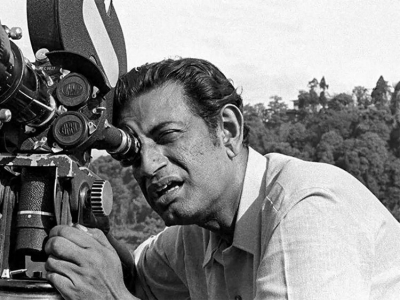
A gifted filmmaker and storyteller, an artist and editor of a children’s magazine, Satyajit Ray wore many hats. But one thing that stood out the most was his love for children and his ability to capture the simple joys of childhood in his works.
The young Apu and his sister Durga from “Pather Panchali” watching a train for the first time; relishing the making of a mango pickle, and attending folk theatre as they lead a simple, rustic life come to mind. The fantastic inventions of the mad scientist Professor Shonku and the Holmes-like Feluda with his trusted sidekicks Topshe and Jatayu never fail to resonate with children.
Who was Satyajit Ray?
Born on May 2, 1921 in an illustrious family in Kolkata, Ray’s great grandfather was Upendrakishore Ray Chowdhury and his father was Sukumar Ray, one of the stalwarts of Bengali literature. Unfortunately, Sukumar passed away when Ray was just two and a half years old. Once, a young Ray met Rabindranath Tagore in Santiniketan and asked for his autograph in his cherished violet coloured notebook. Much to Ray’s delight, not only did Tagore sign his initials, but also wrote a few lines and told him to read it once he grew up. This is what he wrote: “For many a year, I have travelled many a mile to lands far away, I have gone to see the mountains, the oceans. I have been to view. But I failed to see that lay not two steps from my home. On a sheaf of a paddy grain – a glistening drop of dew.” (translation taken from the book “Satyajit Ray in 100 Anecdotes by Arthi Muthanna Singh and Mamta Nainy.”)
Cinemascope
Before he became a filmmaker, Ray worked as a commercial artist. India’s first and only Oscar-winning director, Ray was inspired to become an independent filmmaker after meeting French filmmaker Jean Renoir and watching Vittorio De Sica’s Italian neorealist 1949 film “Bicycle Thieves” in London.
In his long career, Ray directed more than 36 films, including “Pather Panchali” (Song of the Road), which retold Bibhutibhushan Bandyopadhyay’s iconic 1929 novel of the same name. the film won 11 international prizes, including Best Human Documentary at the Cannes Film Festival and an honorary Academy Award in 1992. In the same year, Ray was honoured with the Bharat Ratna, India’s highest civilian award, by the Government of India.
Feluda
Ray’s unbridled imagination and sensitivity is reflected in his short stories and novels for children and adolescents. Ray’s popular “Feluda” series follows the private investigator as he solves complex mysteries using his sharp observational skills. The character made his debut in a crime thriller written by Ray for the Bengali children’s magazine Sandesh in 1965. Over the years, a total of 35 stories in the “Feluda” series were published. Ray even adapted the series to the silver screen, with noted actor Soumitra Chatterjee playing the young and charismatic sleuth.
Shonku and more
Ray also wrote science fiction for kids. His “Professor Shonku” series revolves around a scientist, who makes fantastic inventions in his laboratory. From El Dorado to the prehistoric caves of France to the Nilgiris and the Himalayas, Shonku goes on adventures to different countries and imaginary places.
Another of Ray’s cherished works is the “Goopy Gyne Bagha Byne” series based on his grandfather’s book of the same name. a socio-political satire, Ray weaves a magical tale of the village simpletons Goopy and Bagha. The series is packed with magic, rhyming dialogues, catchy songs, lively dances, and even ghosts (Bhooter Raja).
What’s in store?
- “Another Dozen Stories”, a collection of 12 magical, bizarre and spooky stories for children written by Ry, has been translated from Bengali to English by Indrani Majumdar and will be out on May2. Sharmila Tagore has written the foreword.
- Penguin India is also coming up with “3 Rays: Stories from Satyajit Ray”, a collection of previously unpublished autobiographical writings, stories, poems, illustrations, fiction and non-fiction. The book is expected to be out on May 10.
Oh really?
- Besides filmmaking and writing, Ray had a deep love for typography. He designed the calligraphy in the opening titles for all his films and was credited with contributing several fonts to the Bengali and English language including Ray Roman, Ray Bizarre, Daphnis and Holiday Script.
- After Ray, his son Sandip and other renowned filmmakers have kept the “Feluda” series alive. Even, Bollywood actor Shashi Kapoor played Feluda in a television series “Kissa Kathmandu Ka” in 1986 for Doordarshan.
Picture Credit : Google




